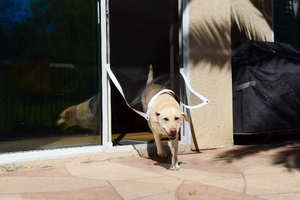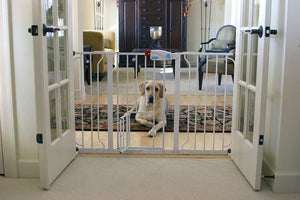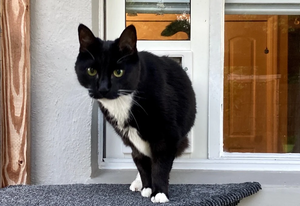Top 3 Reasons Why Your Pet Isn't Using Your Pet Door
- No longer having to schedule and plan around letting the pet out
- No more sudden wake-ups in the middle of the night
- Fewer messes to clean up in the home
- More freedom and more exercise for pets

While all these benefits are great, door training for dogs comes easily to some pets but is a little harder for others. Pet door problems and lack of use can happen for a variety of reasons. Make sure that you choose the right pet door for you and your pet. Here are some of the most common problems people run into:
Your Pet is Afraid of It
Teaching a timid dog to use the dog door is a little tricky. Some animals simply fear the unfamiliar, even if it ultimately improves their quality of life. A new pet door can be confusing to your pet and cause them to shy away or avoid it. If they aren't used to going outdoors without you, they may hesitate to do so on their own.
You can minimize the fear response by praising them whenever they go near the door. Use lots of positive reinforcement, and avoid making using the pet door a stressful experience. Teaching a dog the doggie door isn't a scary or threatening addition is crucial for encouraging them through. Check out our post on training your pet to use a pet door for tips, advice, and recommendations.
Wondering how to train a cat to use a pet door? The process is very similar to dogs. Remember to be patient, and give lots of positive rewards when they walkthrough. Timid cats might benefit from a couple treats on the other end as an incentive.
Wondering how to doggy door train a dog and cat at the same time? For some doors, you can remove a couple of magnets to make them easier to push through. This can help train cats who will be sharing a larger dog door with your pup.
The Door Is Too Small
If you miscalculate the ideal pet door size for your pet, the result may be a door your pet cannot fit through or one that is just too snug for your pet to feel comfortable using. If this is a case, you might follow steps on how to teach a dog to use a doggy door to a T and still run into issues.
When buying a pet door, make sure to accurately measure your pet's width and height, and then buy a door that's a bit larger in each direction. Allow your pets some breathing room; if the fit is too snug, they're more likely to be hesitant about using it.
See our tips on measuring your pet in order to get the correct sizing for your pet door. In the end, getting the right size door will save you money and time.
Improper Training
Pets that weren't properly trained to use a pet door may develop negative associations that result in pet door problems. Improper dog door training makes it very difficult for you and your dog in the long run, so putting in the time to train the dog to use dog door is crucial.
The ideal way to train your pet to use a pet door involves these basic steps and ideas:
- Go outside and encourage the pet to come through the door and join you.
- Use positive reinforcement; give your pets a treat and lots of attention when they use the door successfully.
- Use short training sessions of 10 to 15 minutes per day; don't overwhelm them.
- If they resist using the door, prop the door flap open during training or remove it completely at first to show your pet the outside or what is on the other side of the door.
- If you will be installing multiple pet doors, buy and install the same type of door in all locations to promote consistency. This will help your pet recognize all your pet doors and not have to differentiate.

So how do you train a dog to use a doggy door?
Generally, pets are so happy to be able to go outside that training is a breeze. However, a timid dog doesn't know what a dog door flap is at first, so they will need to be shown how it works. Here are some tips on how to make sure your pet can go through their door easily and safely.
House training a dog to use the pet door is kinda like how you might potty train a new puppy! Repetition and positive reinforcement. Get to training your furry family member to use their very own door!
Right Size Matters
There is nothing more dreadful as getting stuck somewhere you don't want to be. For your pooch, getting stuck in the pet door could ruin their pet door experience permanently.
In order to make sure your pet will properly fit, take necessary precautions when ordering and installing your pet door. Make sure you have read the product description, and that your choice in dog or cat doors fits with the breed of your pet. Make sure to get a small doggy door for a small dog, and a big door for a big, adult dog.
See our measurement guide for tips on choosing the right size. Measuring your pet is an important step when purchasing a pet door.
Dog Training Sessions
-
Limit training sessions to 10 minutes. If your pet does not succeed the first time then schedule higher intervals of sessions throughout the week. Try not to overdo the number of sessions in a day, two well spaced out in one day should be the maximum.
- Hold the flap open all the way at first; then less and less so they gradually get the idea of pushing against it to get to the treat (food is an excellent motivator for most dogs).
- Patience is a virtue: Practice makes perfect, and for some pets it takes a lot of practice before they get used to using it. Be patient, do not push or shove them through the door. The first step is to slowly introduce them to the doggie door. Call your pet over to the pet door and slowly open and close the flap so the pet knows what the pet door does. While you hold it open let your pet peer through the hole and let it realize that it leads outdoors.
- If your pet does not venture through the hole, try coaxing them through with a treat or toy at the other end. Also, try not letting your pet use the real door for further training enforcement. Don’t scold your pet if they do not take to the door right away, it will only lead your pet to have negative emotions about the pet door. Positive reinforcement is key!

How to teach your cat to use their door:
Typically, most cat doors with a flap will not be made of flexible vinyl. Instead, it is hard acrylic. Training a cat will be a little different than how to train the dog to use a pet door and to help familiarize your cat to their new door, you can follow these points:
- Introduce your cat to the product by putting your hand through so they know how it works
- Some cat doors will make a noise when they open/close, this can scare skittish cats, we recommend manually shutting it slowly so your cat can get used to the noise
- Use favorite treats or favorite toy to lure them through- while keeping the flap open so they know how easy it is
- Reward your kitty with praise (and maybe another treat) when they make a pass-through
- When your cat is more comfortable, start lowering the flap on them as they step through
- When training pet door should be at a comfortable height- meaning raise the door enough so it resembles how high it will be once installed
Remember, training can take a considerable amount of time; there is no standard practice as every pet is unique. Try to make this training fun!
Magnet Adjustments
- If your pet door has a moveable threshold at the bottom where it seals, then taping down that threshold will significantly reduce the magnet strength and make the flap easier to push. Dog owners find this valuable when they have small dogs sharing with big dogs.
-
Try removing the magnet for a while so the flap is easier to push. The Endura Flap® based pet doors allow for all magnets to be removed to facilitate training if needed as do all Hale Pet Doors. You may be able to remove the magnets from other flaps also though you may end up damaging the flap in so doing. In the case of the Endura, the threshold may be removed altogether by pulling straight up. Doing this will reduce the magnet strength even more than simply taping the threshold down and will also increase the size of the tempting opening that we think will encourage the pet at the bottom of the flap. Once the threshold is removed, the bottom of the "cover strips" (plastic strips installed in the frame just opposite the edges of the flap) is accessible and you can grip there and pull out to reveal the magnets hidden in the frame sides. If you remove the magnets from the frame sides and the threshold, then there's nothing but the hanging weight of the flap for the pet to push against. See Endura troubleshooting videos for more help.
In the case of Hale Pet Door products, the magnets are installed in the frame and may be pried out with a flat-bladed screwdriver. They can be left out and put back one or two at a time as the pet becomes more accustomed to using their pet door.
- If you have a pet door with non-removable magnets, putting some painters tape over the magnets can also decrease the magnet attraction strengths temporarily.

Flap Adjustments
- Remove the flap altogether temporarily while the pet gets used to the idea of coming and going in that particular location. Or tape the flap up out of the way.
-
Clear flaps may confuse pets as they might view it as a window. Magnetic and weighted flaps have added weight which may be difficult for your pet to lift or push through. While electronic flaps often make a small noise when the flap is activated, which may frighten your pet.
- Putting a piece of masking tape on the clear flap to distinguish it from a window and reinforce to your pet its use as a door.
- Weighted and magnetic doors problems can be fixed by gently assisting your pet to push the door open or by removing the magnet until your pet gets used to the door.
- The best way to remedy a scared pet when it comes to electronic pet doors is to positively reinforce the sound of the door in your pet’s mind. This can include praising your pet when they come near the pet door during its activation noise. If this method does not soothe your pet, try turning off the electronic portion of the door and have your pet use it manually while it’s getting acquainted to the door.
Other Tips
- Consistency is key. The last and most crucial technique in training your pet to use a pet door is to stay consistent. Stay consistent in your training methods and in your choice of pet doors. If you choose to have more than one pet door in your home, picking the same door or similar style doors will help your pet against confusion.
- Electronic pet doors all make a sound when they activate that can spook a pet. Try disabling the electronics for a week or so while he becomes accustomed to the flap if the sound bothers him at first.
- If you have multiple pets you're lucky. The first to learn will demonstrate for the others. Their very own dog trainer!
- When you first use a locking cover or when you first lock the flap shut, introduce the pet to it slowly rather than to let him learn 'the hard way' by running into it.
A pet door can bring enjoyment and independence to both you and your pet. We hope this helped you learn how to teach a dog to go through a dog door! Avoid pet door problems by following the basic tips provided above and visit PetDoors.com for more information.
Always feel free to contact customer service with questions, we are here to help!





Hi Janet,
It is likely that your dog is a little wary of the new scent/look of the replacement flap. I would recommend daily training sessions where you hold the flap open and have someone on the other side coax your dog through with a yummy treat.
Each time she goes through, you can lower the flap a bit until it is touching her back. This will help her learn that the feeling of the new flap is associated with a treat on the other side.
If you have any more questions, please feel free to call us at 1-800-826-2871 or email customerservice@petdoors.com.
Happy New Year!
Our old dog flap of 8yrs broke it was a stay well no problems we have just put a new one which is called petsafe same size as the old one but our dog will not use it at all! I’ve tried coxing with a titbit but no joy. Have you got any answers thank you
Great article, Another trick that I did when I trained my 4 dogs was remove the flap all together for the first couple of days until they got used to going in and out of it, and then I installed the flap with no magnet, a few days later I installed the magnet and I can say that yes it is such a nice feeling knowing that when you go to your job or go to the store that your dogs can go in and out of the house at their own free will.
My dog is a trained service dog, he took to using the dog door. The challenge is that I only let him use it during the day, which he is doing, he has had no issues with peeing or pooping in the house at night, he sleeps very well next to me on my bed. I have the dog door shut when the sun goes down, and now he is just standing in front of the dog door in the morning after I open it. He is a Lakeland terrier, bred to hunt. I will not let him out at night through the house door without a long line. I died saving someone from a burning house, came back alive at the hospital. Chasing squirrels, during the day when he has free time is fun for him. I give him breaks during the day, have large trees and I am a bit concerned if I shut the dog door at night, that will keep him from using it during the day when it is open? any suggestions.? Thank you. He is 3 years old; we have been together for 4 months. My thought is to be firm, fair and consistent. Safety, food, comfort, fun and attention. My first service dog was a Lakeland for 13 years, never had a dog door, she went to work with me. I am now retired. Maybe I just have to give time for him and me to work it out?
Hi Michelle,
Some magnets in pet door flaps can be removed (or the strength adjusted by using less magnets) during the training period so that your dog can get used to that pet door. We might be able to offer some suggestions if we can get more details on your previous and current pet door.
Please don’t hesitate to contact us at customerservice@petdoors.com or 1-800-826-2871 for advice.
We bought a dog door when my murkier was about 6 months old. He quickly learned how to use it on his own any time with no trouble. Because we live in the north and winter is coming we replaced the basic dog door with a magnetic door. He used it for a full day without issue then completely stopped! We have to be right there and crack the door for him to go through. He acts like he has no idea how to use it! It is much too cold to leave the door off. Should we put the old door back on and see how he does?
Hi James,
You may want to talk to a dog behavioralist. It sounds like your pet might have some separation anxiety so maybe they act differently when you are around versus when you’re gone. Good luck!
I have almost the same problem as Misty… Our dog will use the flap for the toilet no problem when we are home (without asking her), but when we go out we always come back to a mess – really frustrsting.
Any ideas please.
Hi Jeff,
You can find bitter spray at most pet stores or on amazon. It gives off a bitter taste so that pets are deterred from chewing on things like furniture and other household items.
Hi Jeff,
You can find bitter spray at most pet stores or on amazon. It gives off a bitter taste so that pets are deterred from chewing on things like furniture and other household items.
Our dog is having an allergic reaction to the plastic of the doggy door. Is there a light weight coating I can apply to the flap to remedy this?
We adopted our dog Fester (pit / English bulldog mix) 2 years ago. He took to the doggy door instantly and he liked hanging out in his dog run. The last week he refuses to go out to his dog run and he keeps having accidents in the house. It is like he is afraid to go out there all of a sudden. I watched him go out the dog door and instantly run back into the house and then pee in the house. We aren’t seeing anything outside. What could have caused such a sudden change.
My pet door is right next to the patio door. They see their reflection at night in the patio door and think theres a dog outside so they are afraid to use it . geez.
Hi Eva and Justin,
It seems that you may need to talk to a pet behavioralist about why your dog might be acting this way. If we can assist you in any other way, please feel free to contact us at customerservice@petdoors.com.
Thank you!
My 7 year old dog has used a doggy since she was a puppy. She now does not go in and out of it. She looks hesitant to get near it. We haven’t changed anything. Do you know what we should do?
Our English Mastiff goes out the dog door with no issues, but refuses to go back inside through the door. We have tried training with treats but he cowers down any time we bring him near the door. The door is huge and we have no idea what has happened to make him this way.
My dog has used the dog door for a couple years. I replaced the dog door with a 3 flap dog door to help with the weather. Now she’ll go out but won’t come back in. Have tried removing the flaps and the most she’ll do is stick her head through. Any ideas?
Hi Eric,
I would recommend talking to a dog behavioralist if your dog continues to not be able to use the pet door with the flap down. If your dog seems to be hesistant about going through the flap because of the magnet strength, certain brand pet doors (like the Endura Flap) have removable magnets so you can have your dog get used to going through the pet door without the flaps being too heavy. Another idea might be to prop the flap open just enough so that your dog can see where it’s going. This might encourage them to step through (especially if you bribe them with a treat!).
If you have any additional questions, please feel free to contact us at customerservice@petdoors.com!
I have 2 Boston’s and one took to the door the day we put it in. The other uses it if the flap is taped up but once it’s down he won’t use it. We try twice a day with treats but no avail. We are taking it slow but it’s been about 2 weeks and no progress any ideas
Hi Shari,
Interesting situation. I would recommend leaving a tread just in front of the doggy door flap inside the house, just out of reach from your dog when he sticks his head in. Maybe this will train him to come in by himself. Otherwise, you can speak to a local animal behavioralist to see why your dog might be hesitant to come inside the doggy door.
Thanks for reaching out! If you have any other questions, please feel free to contact us at customerservice@petdoors.com!
Our dog has used the doggy door for over a year now he doesn’t want to come back thru it at night. Sometimes just stands there and barks or will even Stick his head inside and bark. We have to get up go out and tell him to come in and then he comes in. Any ideas?
Hi Courtney,
Great question! Have you tried training her to go through the pet door right around the time she usually takes a potty break? This way, she might start associating going through the doggy door with doing her business outside. If this doesn’t work, you can also speak with a local pet behavioralist to figure out what the issue is.
Our dog LuLu does great with the dog door. She doesn’t seem to have any apprehensions about using it and we taught her how to go in and out with many of the tips you provided above. So why am I writing? It appears she is under the impression that we have to be next to her for the door to open. We basically walk her to the dog door, encourage her to go outside and go potty, she then goes through the door and then she comes back in after she is done being outside. How can we get her to use it on her own???
Hi Jana,
You might be successful trying to have the flap slightly propped open and try coaxing your dog out on the other side with a treat. That way, they can get used to the flap being there but can be reassured that it can open.
My year old pup is great with the dog door WITHOUT FLAPS on. We are getting a kitten in a month and really need to use the flaps. I’ve been trying these techniques but when the flap touches him he freaks out. Any other advice for the flaps specifically?
My 1 year old miniature poodle will go through the doggie door during the day on her own when she wants to play outside. She’ll even SOMETIMES use it to do her business, but if we are not home, she will NOT go out there on her own. We always come home to mess in the house. She also won’t go through the door at night unless I’m with her. For some reason she thinks she’s not supposed to pee unless I’m standing there watching her. She holds it until she just can’t hold it anymore, then instead of running outside on her own she goes on the floor! It’s driving us crazy! She does use the door when she wants to run and play, but I can’t get it through her head that she can go potty without me watching her!
My 16 week old puppy loves to RUN in and out the doggie door. She does it all day long. However, she will not use it to go out and do her business! She (sometimes) goes to the patio door or I have to remember to take her out.
Can you give me some suggestions?
Thanks.
P.s. she is a Lhasa Apso